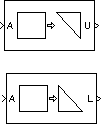Extract Triangular Matrix
Extract lower or upper triangle from input matrices
Libraries:
DSP System Toolbox /
Math Functions /
Matrices and Linear Algebra /
Matrix Operations
Description
The Extract Triangular Matrix block creates a triangular matrix output from the upper or lower triangular elements of an M-by-N input matrix. The block treats length-M unoriented vector inputs as an M-by-1 matrix.
Examples
Ports
Input
Output
Parameters
Block Characteristics
Data Types |
|
Direct Feedthrough |
|
Multidimensional Signals |
|
Variable-Size Signals |
|
Zero-Crossing Detection |
|

